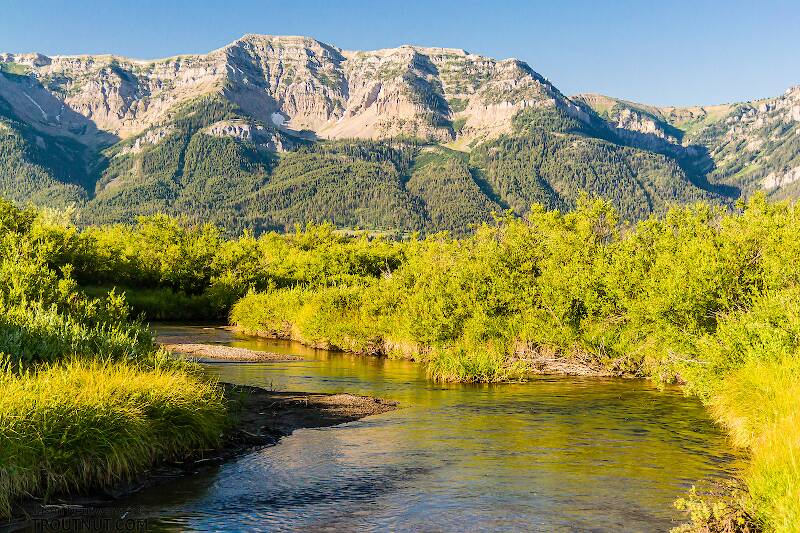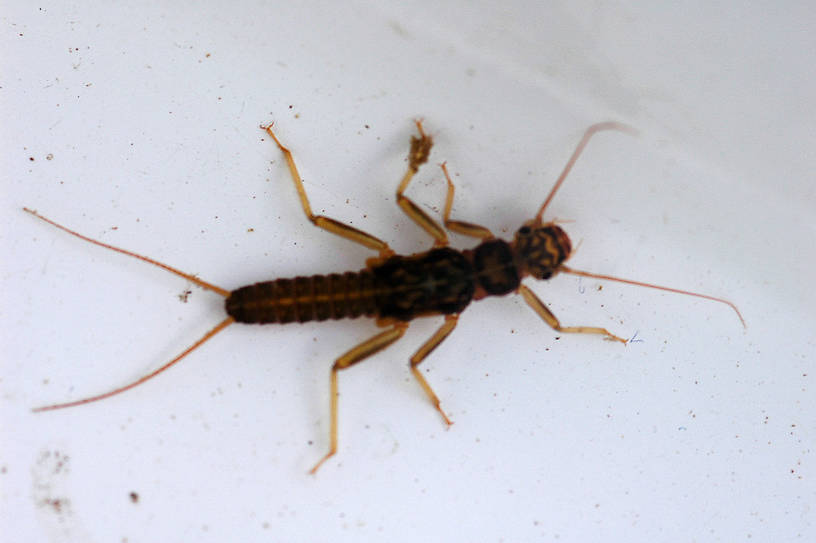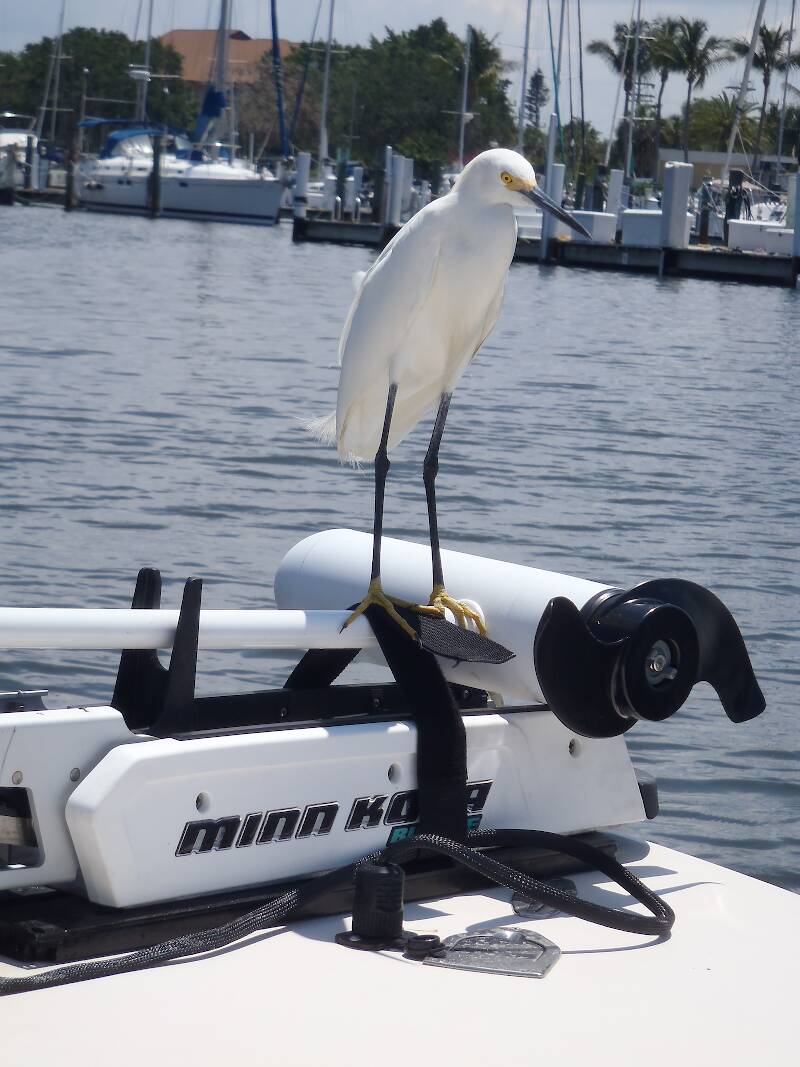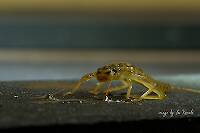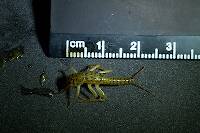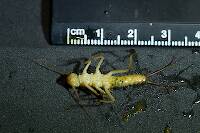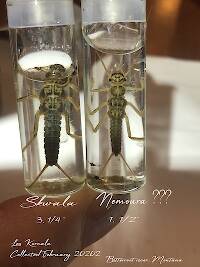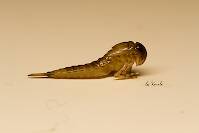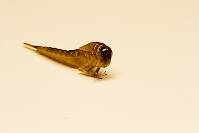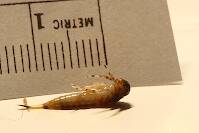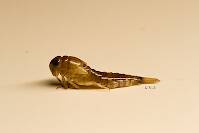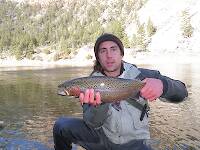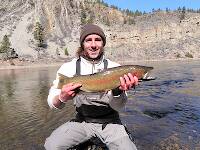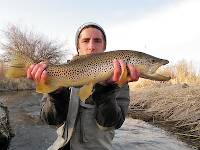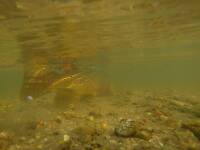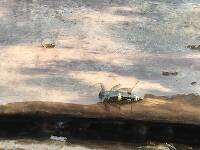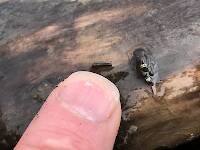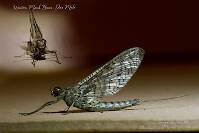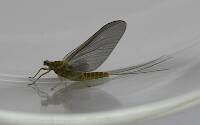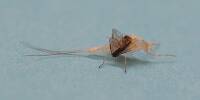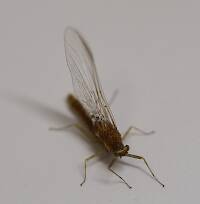
Hex Mayflies
Hexagenia limbata
The famous nocturnal Hex hatch of the Midwest (and a few other lucky locations) stirs to the surface mythically large brown trout that only touch streamers for the rest of the year.
Featured on the forum

It's only barely visible in one of my pictures, but I confirmed under the microscope that this one has a prosternal horn and the antennae are mid-way between the eyes and front of the head capsule.
I'm calling this one Pycnopsyche, but it's a bit perplexing. It seems to key definitively to at least Couplet 8 of the Key to Genera of Limnephilidae Larvae. That narrows it down to three genera, and the case seems wrong for the other two. The case looks right for Pycnopsyche, and it fits one of the key characteristics: "Abdominal sternum II without chloride epithelium and abdominal segment IX with only single seta on each side of dorsal sclerite." However, the characteristic "metanotal sa1 sclerites not fused, although often contiguous" does not seem to fit well. Those sclerites sure look fused to me, although I can make out a thin groove in the touching halves in the anterior half under the microscope. Perhaps this is a regional variation.
The only species of Pycnopsyche documented in Washington state is Pycnopsyche guttifera, and the colors and markings around the head of this specimen seem to match very well a specimen of that species from Massachusetts on Bugguide. So I am placing it in that species for now.
Whatever species this is, I photographed another specimen of seemingly the same species from the same spot a couple months later.
I'm calling this one Pycnopsyche, but it's a bit perplexing. It seems to key definitively to at least Couplet 8 of the Key to Genera of Limnephilidae Larvae. That narrows it down to three genera, and the case seems wrong for the other two. The case looks right for Pycnopsyche, and it fits one of the key characteristics: "Abdominal sternum II without chloride epithelium and abdominal segment IX with only single seta on each side of dorsal sclerite." However, the characteristic "metanotal sa1 sclerites not fused, although often contiguous" does not seem to fit well. Those sclerites sure look fused to me, although I can make out a thin groove in the touching halves in the anterior half under the microscope. Perhaps this is a regional variation.
The only species of Pycnopsyche documented in Washington state is Pycnopsyche guttifera, and the colors and markings around the head of this specimen seem to match very well a specimen of that species from Massachusetts on Bugguide. So I am placing it in that species for now.
Whatever species this is, I photographed another specimen of seemingly the same species from the same spot a couple months later.

Troutnut is a project started in 2003 by salmonid ecologist Jason "Troutnut" Neuswanger to help anglers and
fly tyers unabashedly embrace the entomological side of the sport. Learn more about Troutnut or
support the project for an enhanced experience here.
Gillybilly on Mar 3, 2013March 3rd, 2013, 8:18 am EST
I wonder if anybody out there has identified and/or photographed the Skwala on the Flathead river(s) in NW Montana?
Bnewell on Mar 3, 2013March 3rd, 2013, 10:48 am EST
There are only two Skwala species in NW Montana. Check out the Ph. D. dissertation of Jack Stanford who worked on the Flathead River for several years driving over 100,000 miles. Also check the following: "The Stoneflies of the Rocky Mountains" by Baumann, Gaufin and Surdick, 1977. The Stoneflies of Montana, 1972, Gaufin et al. "The stoneflies of Glacier National Park and Flathead River Basin, Montana, Newell, Baumann and Stanford, 2008, IN, International Advances in Ecology, Zoogeography, and Systematics of Mayflies and Stoneflies, Univ. of California Publ, Entomology, Vol. 128, pages 173-186.
I have many photos of Skwala but don't think any of them are from the Flathead River, Montana.If you want to see specimens visit the Flathead Lake Biological Station at Yellow Bay and see their reference collection and talk to the Director Jack Stanford.
Bob Newell
I have many photos of Skwala but don't think any of them are from the Flathead River, Montana.If you want to see specimens visit the Flathead Lake Biological Station at Yellow Bay and see their reference collection and talk to the Director Jack Stanford.
Bob Newell
Sayfu
Posts: 560
Posts: 560
Sayfu on Mar 3, 2013March 3rd, 2013, 12:09 pm EST
There is a good article in the new FlyFisherman Mag. The Bitterroot gets a good Skwala hatch. My Yakima that I use to guide on in Eastern WA is really featured in the article. What was interesting to me is in the lower elevations like my Yakima they can come off earlier (late Feb./Mar. and in the higher elevations like the Bitterroot going East they come off somewhat later because of water temps. AND...the higher elevation later arriving Skwalas will appear darker than the lower elevation Skwallas. The Yakima bugs are a dirty yellow body, and the Bitterroot dark green to almost black in appearance.
Entoman on Mar 3, 2013March 3rd, 2013, 1:38 pm EST
...the higher elevation later arriving Skwalas will appear darker than the lower elevation Skwalas.
Yes, I've noticed this myself, and they are smaller as well. I have written what I know about this genus in the hatch page that you may find interesting to review. We have the same big pale ones on the Lower Yuba. It is a very significant hatch on this water and it's happening right now.
There are only three species in North America, curvata, compacta and americana. They don't occur together that I'm aware of. Could the color and size contrasts be ascribed to the differences between the species or are they due to thermal/elevation/latitude influences causing variation? I've yet to read or hear an explanation.
"It's not that I find fishing so important, it's just that I find all other endeavors of Man equally unimportant... And not nearly as much fun!" Robert Traver, Anatomy of a Fisherman
Gillybilly on Mar 4, 2013March 4th, 2013, 5:19 am EST
Awesome! We're having a warm winter here in NW Montana this year and the river temp's are already approaching 40 degrees. I've fished the skwalas here on the North Fork but usually later in March, early April. I wonder if you know if their hatch moves from down stream up as does Salmon Flies? Thanks!
Entoman on Apr 20, 2013April 20th, 2013, 6:13 pm EDT
Welcome to the forum, Gillybilly.
I apologize for the late reply. As to your question, in my experience the answer is no. They seem to prefer certain stretches and will continue their activity there quite awhile. That and being the first big bug of the year is why this is such a great hatch in up cycles of their populations...
I apologize for the late reply. As to your question, in my experience the answer is no. They seem to prefer certain stretches and will continue their activity there quite awhile. That and being the first big bug of the year is why this is such a great hatch in up cycles of their populations...
"It's not that I find fishing so important, it's just that I find all other endeavors of Man equally unimportant... And not nearly as much fun!" Robert Traver, Anatomy of a Fisherman
Leskorcala
Posts: 16
Posts: 16
Leskorcala on Feb 20, 2020February 20th, 2020, 5:12 pm EST
I do have many images of Skwala from Bitterrot river in Montana if you would like to see it.
les
les
Quick Reply
Related Discussions
Topic
Replies
Last Reply
2
Feb 24, 2020
by Leskorcala
by Leskorcala
2
Mar 6, 2020
by Swpabrown
by Swpabrown
4
Apr 10, 2020
by Konchu
by Konchu
2
Apr 10, 2020
by Partsman
by Partsman
0
May 27, 2018
by Leskorcala
by Leskorcala
4
Apr 12, 2014
by Brookyman
by Brookyman

